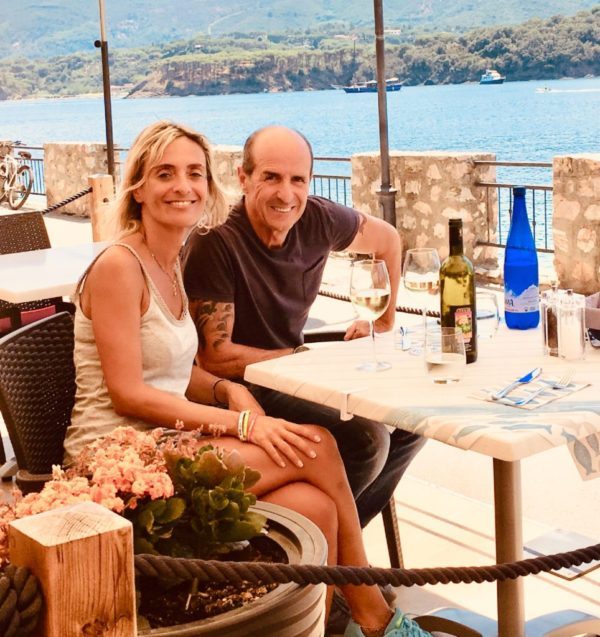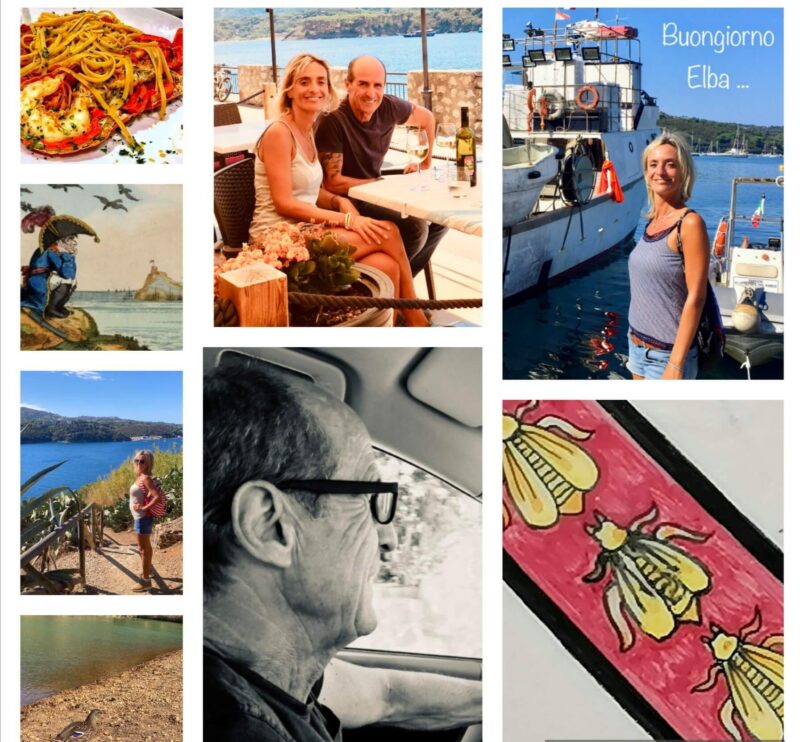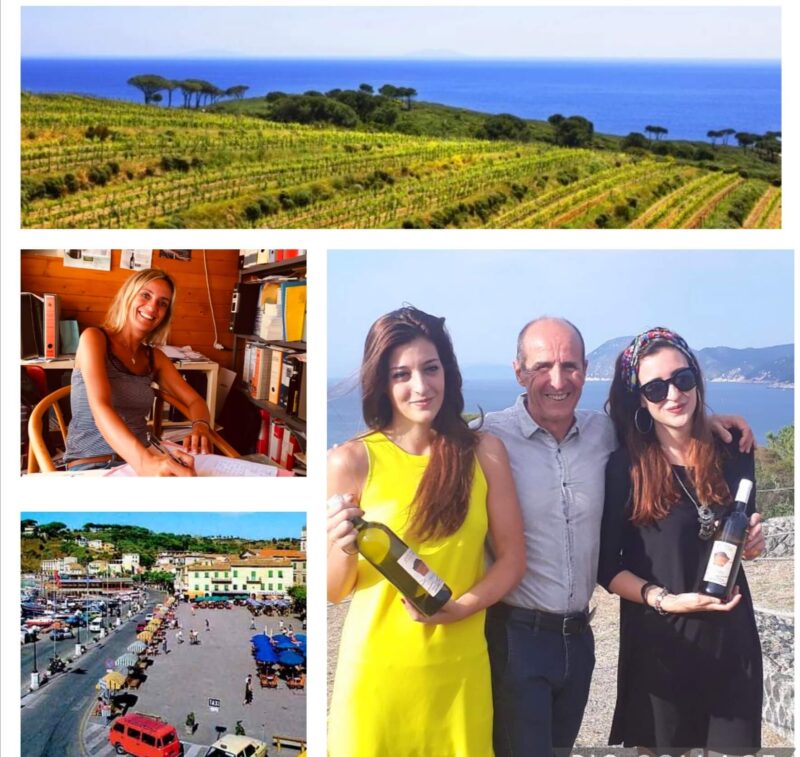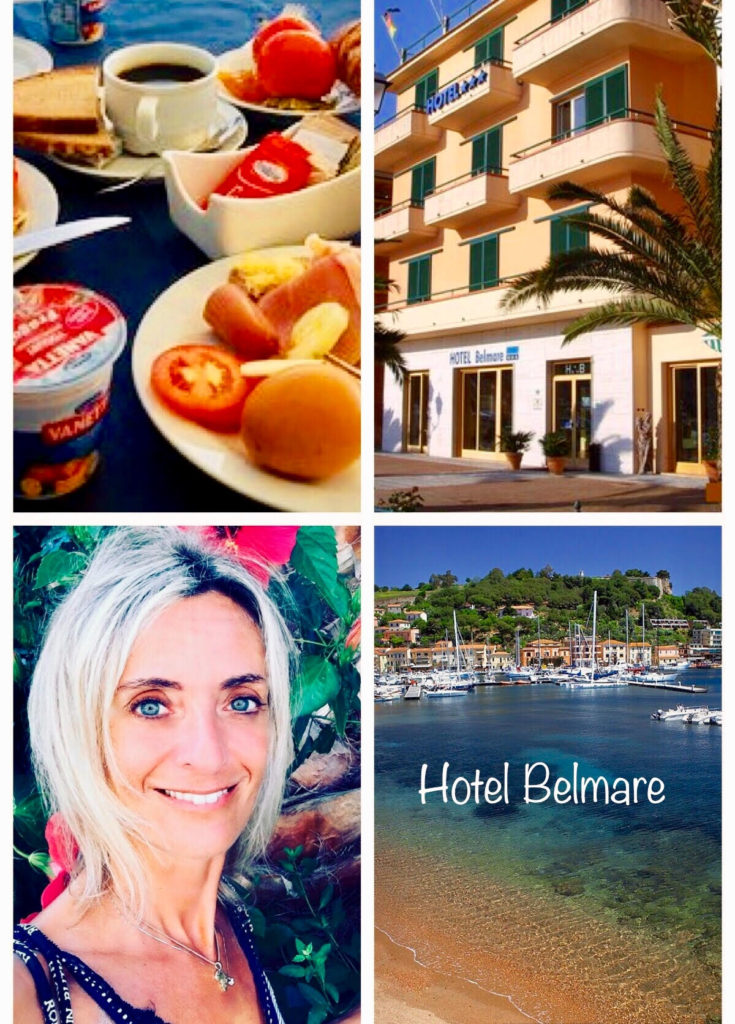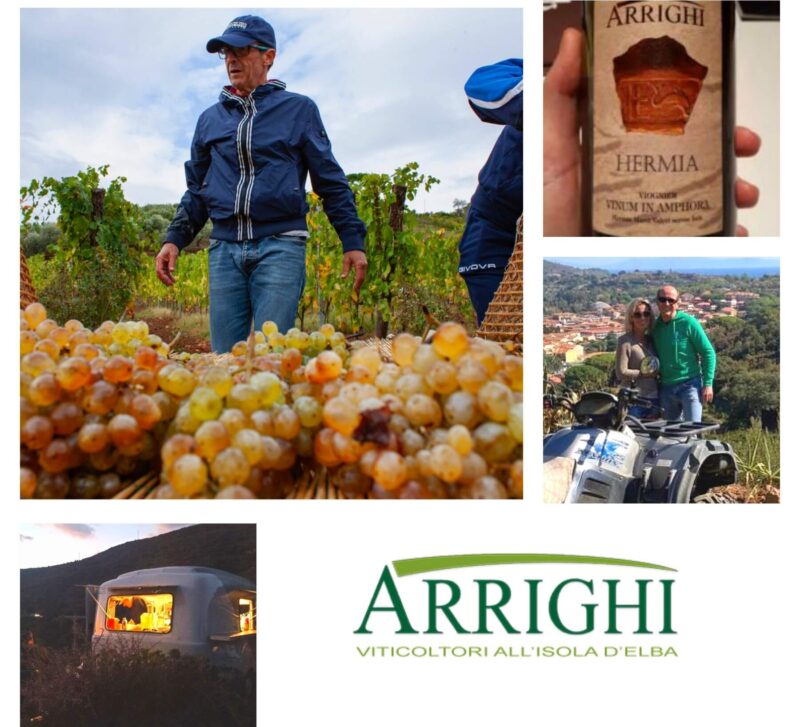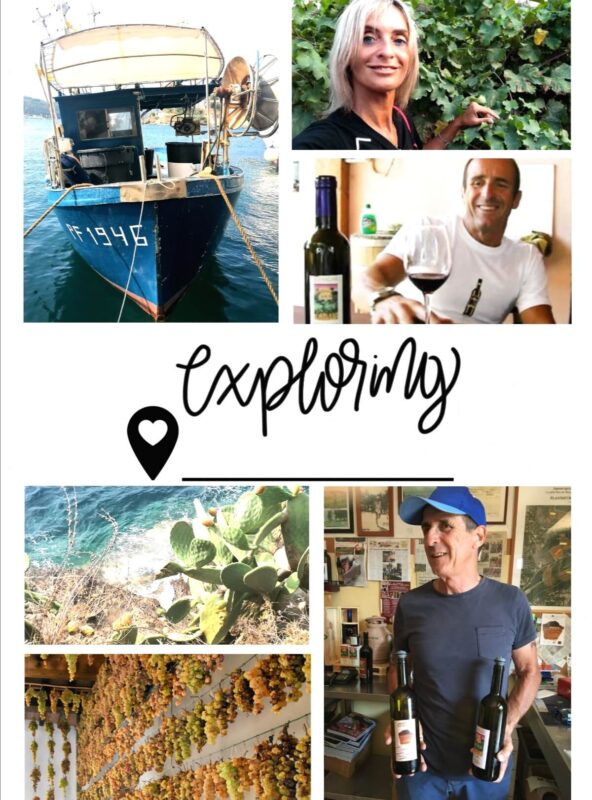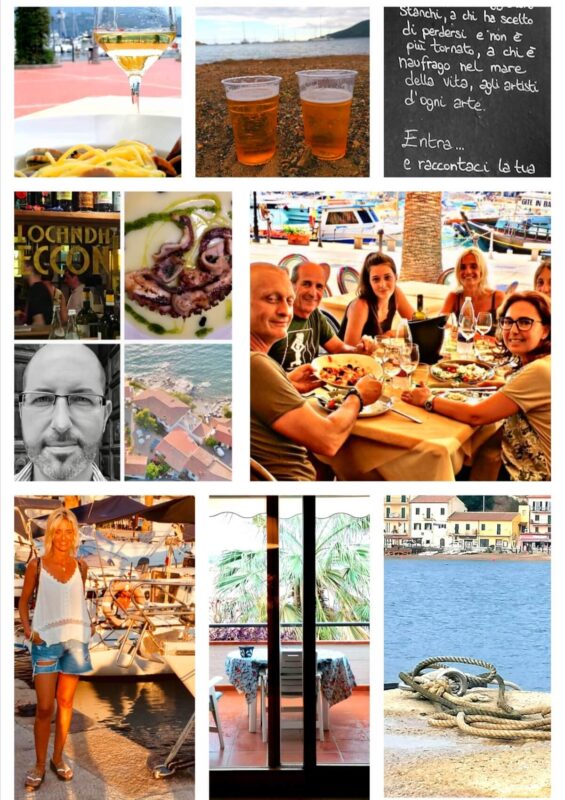“La qualità non è mai casuale; è sempre il risultato di uno sforzo intelligente.”
“Cantina Arrighi”, Elba
Il vino della “Cantina Arrighi” mi porta per una seconda volta all’ Elba! Antonio Arrighi suo proprietario e grande winemaker mi viene a prendere in auto a Portoferraio un weekend di fine estate. Ci siamo diretti a Porto Azzurro sede dell‘azienda vinicola in viale Europa, Pian del Monte, 57036 . In questa ridente cittadina ci sta anche l’albergo “Hotel Belmare” , dove ho nuovamente alloggiato. Qui nella stanza numero 13 è nato Antonio Arrighi! Un uomo straordinario che oltre a essere il numero uno nel suo lavoro, è un fuoriclasse nella vita!
Grazie alla “Cantina Arrighi” ho avuto la possibilità di appronfondire la conoscenza dei nettari dell’ Elba , della sua storia e di cosa c’ è da vedere su questo incantevole atollo toscano. Seguitemi in questa avventura che voglio condividere con voi, suggerendovi qualche cosa di davvero interessante da non perdervi nella vostra prossima vacanza sull’isola!
“Cantina Arrighi” a Porto Azzurro, un borgo fatato
AL mio risveglio in camera il sole fuori è appena spuntato ed è ancora caldo. Esco fuori a Porto Azzurro, che ormai mi è familiare. Faccio colazione seduta davanti il mare in un baretto nel porticciolo. Sembra di essere dentro un quadro di Monet.
Tutte le barchette variopinte in fila, che dondolano al ritmo delle piccole onde insieme agli yacht a più piani dei ricchi Inglesi attracati alla darsena. I gabbiani che librano liberi nell’aria, e qualche vagabondo che come me si aggira nel salotto di piazza Giacomo Matteotti a Porto Azzurro per godersi il silenzio del mattino. Non ho un programma preciso, sono senza orologio, e l’unica cosa che desidero e perdermi tra i vicoli stretti di questo borgo medievale, pieno di localini e botteghe artigianali che lo rallegrano e lo rendono così glamour e alla moda.
“Oasi degli dei” , Porto Azzurro, Elba
Il mio pelelgrinaggio inizia al lungomare di Porto Azzurro. Mi fermo a osservare dei bambini, che si infilano in una fontana a giocare con gli zampilli d’acqua che rinfrescano i passanti. Ad un certo punto vicino la banchina del porto turistico , mi ritrovo davanti l’ “Oasi degli Dei” . Si tratta di cinque statue di marmo di Carrara create da artisti del calibro di Raphaelle Duval, Christian Ibanez e Franco Dagab raffiguranti:
Per cinque anni queste divinità marmoree hanno abitato le acque di “Punta Polveraia” a “Marciana” dietro iniziativa di Giorgio Verdura, che è un sommozzatore professionista,. E poi sono state tirate fuori per essere esposte in una sorta di museo all’aperto che impreziosisce Porto Azzurro .
La “Passaggiata Carmignani”, dal centro di Porto Azzurro
Dal centro di Porto Azzurro a pochi passi dalla spiaggetta cittadina mi sposto alla “Passeggiata Carmignani” , che in salita su degli scalini (portate acqua e scarpe comode!) mi conduce fino alla “Spiaggia Barbarossa”. Qui faccio purtroppo il mio ultimo bagno! Senza dubbio Settembre è il periodo migliore per vivere l’ Elba , perché le temperature sono miti e piacevoli. Oltretutto lontano dalla massa dei turisti dell’alta stagione si possono girare altri posti affascinanti come per esempio:
- “Capoliveri”;
- Il laghetto di “Sassi Neri”;
- Il monte “Capanne” (1019 metri raggiungibili dalla funivia di “Marciana”);
- Le spiagge di “Cavoli”, della “Biodola”, di “Padulella”, di “Sansone”, di “Marciana”, della “Fetovia”
Sul tardo pomeriggio mi avvio verso la cantina dove trovo Antonio Arrighi affaccendato nel suo tran tran quotidiano . Ci saranno stati almeno una decina di wine lovers giunti apposta per le degustazioni, e per sapere del misterioso “Nesos” , il vino salato . Altra magia di Antonio Arrighi!
” Cantina Arrighi”, un modo per scoprire la storia dell’ Elba
Secondo una leggenda Venere , la dea della bellezza e dell’amore, avrebbe perso una collana di perle nel Mar Tirreno, dando così vita all ‘ “Arcipelago Toscano” di cui l’Elba fa parte . L’Elba si trova a 6,2 miglia dalla città costiera di Piombino . Con un’area di 86 miglia quadrate (223 km quadrati), è un paradiso toscano incontaminato: limpide acque blu, coste infinite, paesaggi meravigliosi, clima mediterraneo ed una natura rigogliosa .
L’ Elba , inoltre, è una terra ricca di una cultura vitivinicola che è antica tanto quanto la sua storia. L’Elba è stata abitata sin dall’epoca preistorica. Ed essendo piena di depositi di minerale ferroso l’Elba, ha attirato molti colonizzatori. Gli Etruschi ed i Greci la chiamarono “Aethalia” (che significa “luogo fumoso”, probabilmente a causa della presenza di fornaci). Successivamente i Romani la ribattezzarono “Ilva” , ovvero “ferro”, stabilendovi una base navale.
Seguirono altre dominazioni durante il Medioevo: Pisa e Genova se la contesero fino al governo dei “Duchi di Piombino” 1399 e di Cosimo I dei Medici di Firenze nel 1548. Dal 1596 al 1709 la parte orientale dell’ Elba passò invece sotto il controllo dell’Impero Spagnolo per circa 150 anni. Poi tutto il territorio fu conquistato prima da Napoli e infine dai Francesi nel 1802.
Napoleone all’Elba
Quando Napoleone I abdicò nel 1814, venne esiliato all ‘Elba , dove sbarcò il 4 maggio. Da allora, l’ Elba fu riconosciuta come principato indipendente con Napoleone come suo re fino al 26 febbraio 1815, giorno in cui tornò in Francia per i “cento giorni“. Napoleone lasciò il suo marchio con le sue residenze nobiliari a Portoferraio , capoluogo dell’Elba :
Successivamente, l’ Elba fu restituita alla Toscana , con la quale si annettè all’Italia unificata nel 1860 . L’Elba merita di essere vista anche per i sapori della sua cucina , composta da piatti semplici e fantasiose. Una cucina per lo più a base di pesce, che qui abbonda come i suoi deliziosi ristorantini sparsi ovunque. Questi vengono riforniti da tutti quei pescatori , che ogni mattina vanno al largo con le loro barche, e le riempiono di polpi, stoccafissi, totani, e sardine.
Antonio Arrighi , da direttore d’albergo all’Elba a winemaker
Antonio Arrighi è Elbano DOC. Il mitico vigneron è cresciuto in una famiglia di albergatori e ristoratori esperti , che vantano un lungo trascorso nell’ accoglienza turistica all’Elba a partire dal 1960, gli anni d’oro del boom del turismo e del rilancio finaziario. Parimenti i suoi genitori si dedicano a tirare su un’azienda agricola pensata per lo più per i loro stessi clienti, producendo diversi tipi di carne (maiale, coniglio, ecc.), fiori, e frutta (pesche e uva).
Antonio Arrighi, sommelier ‘AIS Toscana’
Da bambino Antonio Arrighi è sempre stato coinvolto dietro le quinte negli affari di famiglia. Nel 1980 decide di diventare sommelier (fa ancora parte della delegazione Elba di “AIS” Toscana” ), non solo per prendersi cura dei suoi vigneti, ma anche per fare dell’ottimo vino!
Nel 1995 Antonio Arrighi ha davanti a sé una grossa opportunità: intraprendere un ambizioso progetto in collaborazione con la “Regione Toscana” e con Paolo Storch , senior researcher del “CREA” (“Assessorato alla Ricerca Agraria di Arezzo”) . Lo scopo è quello di capire quali vitigni internazionali insieme a quelli locali possono crescere all’Elba .
La risposta a questa domanda è stata: Syrah , Sagrantino e Tempranillo per i vini rossi, ed Incrocio Manzoni , Chardonnay e Viognier per i vini bianchi. Antonio Arrighi ha continuato a piantare tutte queste varietà di uva internazionali selezionate nella sua terra, essendo resistenti alla siccità ed alle malattie, rispettando parimenti elevati standard di qualità.
Giulia e Ilaria , i gioielli di casa Arrighi
Dal 2000 in poi, Antonio Arrighi si è dedicato completamente alla sua passione vinicola, che si è trasformata nel suo mestiere principale aiutato dai suoi cari. Per il futuro della “Cantina Arrighi” può’ contare sulla bravura delle figlie Giulia e Ilaria , enologa la prima, esponsabile comunicazione e marketing la seconda .
Il cambio generazionale della sua azienda ha base solide dunque, rafforzato anche dal piccolo Matteo avuto dall’attuale compagna Giada . Tutti quanti insieme sono una forza! Si dice che l’umiltà appartiene ai grandi, ed è il loro caso! Appena li conosci è inevitabile non cadere vittima della loro professionalità, genuinità e calorosa ospitalità, e di conseguenza ti ci affezioni!
Perché i vini della “Cantina Arrighi” sono così ricercati?
Antonio Arrighi è sempre lo stesso, in formissima, vivace, sorridente e pieno di cose da fare. Contenti di parlare nel suo ufficio di presenza dopo il Covid 19 si chiacchiera su come il settore vitivinicolo abbia risentito bruscamente della crisi per la pandemia. Per fortuna Antonio Arrighi mi dice che si è ripreso e che i suoi ritmi produttivi sono pressoché gli stessi di prima.
Tuttavia, mi confessa che ci sono stati momenti di smarrimento, che però sono stati seguiti da altri di riflessione su come investire e fare di più! Mi spiega Antonio Arrighi che l’obbiettivo è quello di ingrandirsi e di mantenere il sapere e la tradizione della viticoltura elbana con uno sguardo verso il futuro, mediante l’uso di strumenti sempre più moderni. Cerchiamo di capire meglio dove su quale versante isolano si apre il tesoro di questo alchimista elbano!
Elba, terroir unico al mondo
L’oro rosso e bianco dell’eden di Antonio Arrighi è posizionato a “Piano al Monte” , nelle colline orientali di Porto Azzurro , all’interno del “Parco Nazionale dell’Arcipelago Toscano”. Con una produzione di circa 40.000 bottiglie annue , la proprietà di Antonio si estende su 12 ettari, di cui sette coltivati a vigneto ed il resto ad alberi d’ulivo.
L’obiettivo dell’impresa di Antonio Arrighi è produrre vino dai propri vitigni e sperimentarne altri nuovi, di quelli che chiaramente si adattano meglio al terroir dell’Elba . Un’oasi fatta di ferro, argilla, mare, sole e clima temperato tutto l’anno (la temperatura media annuale è intorno ai 17 ° C con precipitazioni relativamente limitate, concentrate generalmente in autunno e inverno ).
Terreni dell’Elba
L’Elba strega chiunque per la sua bellezza che si distingue per un’ immensa varietà di paesaggi, che sono importanti non solo per far arrivare visitatori! Con un terzo della superficie al di sopra dei 200, l’Elba può essere suddivisa in aree con terreni molto dissimili tra loro. Questi terreni sono il risultato di diverse stratificazioni geologiche, quando essa ha fatto da collante tra la penisola italiana e la Corsica. La parte occidentale dell’Elba è piuttosto montagnosa, mentre quella centrale ha suoli sedimentari sabbiosi ed argillosi.
Questa geografia così interessante garantisce dell’ottimo vino con caratteristiche organolettiche uniche ed un’ampia scelta tra tipi di rossi e bianchi! Ovviamente Antonio Arrighi spera che tutto proceda per il meglio, e che per via della pandemia non ci siano danni nefasti per il turismo. Questo è motore stesso della sua attività, che è sempre più in crescita grazie non solo perché la cantina si trova a soli dieci minuti di passeggiata dal centro di Porto Azzurro, ma anche per i percorsi di wine trekking al suo interno. Si rimane incantati dagli anfiteatri di filari di un verde sfavillante, che sono disposti l’uno accanto all’altro in modo armonico come le note di uno spartito, che danno vita ad una musica infinita.
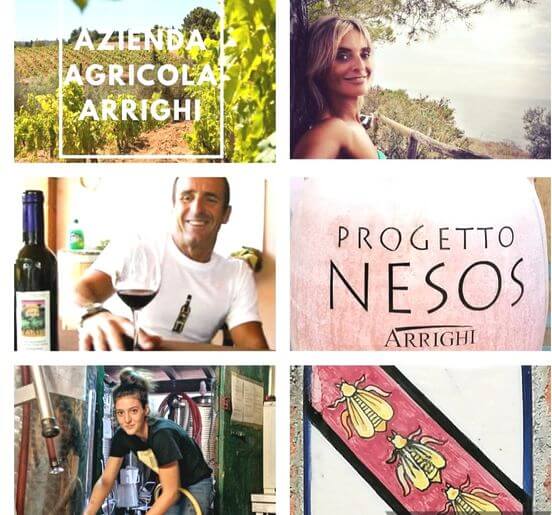
Il vino elbano, una tradizione millenaria
Antonio Arrighi crede ciecamente nell’enorme potenziale dell’Elba come regione vinicola, confermato dal suo passato glorioso di coloni greci (X secolo a.C.), etruschi (VI secolo a.C.) e romani (V secolo a.C.), che lasciano segni indelebili del loro sapere enoico. Come ad esempio la vinificazione in anfore di terracotta, antica tecnica che Antonio Arrighi ha iniziato ad intraprendere con rigore scientifico nella sua cantina.
Tutto questo ha già suscitando molto scalpore! L’Elba è stata sempre un’area a vocazione fortemente enoica, come dimostrano due scoperte del 2013:
- Cinque grandi anfore in terracotta (1500 litri ciascuna) in una villa romana in una zona chiamata “Le Grotte”;
- Altre anfore trovate a bordo di relitti romani disperse nei fondali.
E la storia continua! Non ci sono prove relative alla viticoltura elbana durante il Medioevo. Tuttavia, è documentato che il vino elbano godesse di buona reputazione e di un commercio a prezzi equi in Toscana . Alla fine del Settecento e per tutto l’Ottocento la viticoltura elbana è stata protagonista di un notevole sviluppo grazie alle politiche di salvaguardia di Napoleone .
Tra il 1850 ed il 1860 invece ci sono alti e bassi. Comunque l’Elba è costellata da vigneti a terrazze, che coprono i pendii alti fino a 400 metri sul livello del mare, i quali diminuiscono in numero nel 1960 a causa dell’urbanizzazione e del boom del settore turistico .
Terrazzamenti di vigne elbani
La situazione corrente non è delle più felici, considerando che dei numerosi vigneti , che coprono circa 300 ettari dell’ Elba, solo circa 125 sono iscritti nel “Registro Nazionale delle Varietà delle Viti”. Per non parlare del fatto che la maggior parte dei precedenti terrazzamenti sono ricoperti di cespugli, alberi selvatici, ed edifici!
Tuttavia, negli ultimi anni i vini elbani stanno rinascendo grazie all’impegno e alla dedizione di cantine ben organizzate e associazioni locali, il cui scopo è la valorizzazione, la promozione e la crescita economica di questo angolo di paradiso.
I vitigni della “Cantina Arrighi” all’Elba
Dalle bottaie dell’impresa agricola facciamo un salto ad un pub di Porto Azzurro per un apericena. Qui Antonio Arrighi mi racconta dei suoi vitigni, che sono poi quelli storici dell”Elba :
- Procanico (o Trebbiano);
- Ansonica (o Inzolia);
- Biancone;
- Riminese (o Vernaccia);
- Sangioveto ;
- Tintiglia ;
- Aleatico ;
- Incrocio Manzoni;
- Chardonnay ;
- Riesling ;
- Pinot Bianco ;
- Viognier ;
- Syrah;
- Sagrantino ;
- Tempranillo .
Ovviamente mi sono resa conto che la migliore qualità di Antonio Arrighi è la creatività. Una volta immaginato un vino lo realizza poi nella sua cantina. Questo perché, come dice lui stesso :
“la vinificazione è un’arte oltre che una scienza, e avere la capacità di pensare fuori dagli schemi e di improvvisare, quando necessario, sono abilità critiche per avere successo”.
10 vini della “Cantina Arrighi” . l’Elba in un bicchiere!
Antonio Arrighi è un intuitivo, vuole spingere il terroir dell’ Elba fino al suo massimo potenziale, per ottenere dei vini di grande spessore, che riflettano la loro origine. Se volete carpire l’anima dell’Elba veniteci, e qui vi aggiungo altri nove buoni motivi per concedervi questo privilegio:
- “Ilagiù Elba Bianco DOC” : è un vino minerale e fruttato, composto per l’80% da Procanico e da una piccola quantità di Biancone, ed Ansonica . La sua fermentazione avviene in serbatoi di acciaio inox a temperatura controllata;
- “Era Ora Bianco IGT”: è un vino bianco rotondo, secco e di buona acidità, ottenuto da Chardonnay ed Incrocio Manzoni . La sua fermentazione avviene in vasche di acciaio inox a temperatura controllata, e parte di questo vino è stato affinato in barriques di rovere francese;
- “Mattanto DOC” : è composto al 100% da Ansonica (5000 piante per ettaro), ha un sapore asciutto, pieno e morbido. La sua fermentazione avviene in serbatoi di acciaio inox a temperatura controllata;
- “VIP Viognier White IGT” : è uno dei miei preferiti! È un vino bianco minerale e fruttato, composto al 100% da Viognier (6000 piante per ettaro). La sua fermentazione avviene in serbatoi di acciaio inox a temperatura controllata con tre mesi di affinamento in bottiglia;
- “Hermia Vinum in Amphora White IGT “ : è un particolare vino bianco fatto 100% da Viognier , si presenta fine e leggero grazie ad una vinificazione naturale ottenuta con anfore in terracotta di firmate “Artenova” di Impruneta (800 litri di capienza) . Fa unga macerazione a contatto con le bucce e sei mesi di invecchiamento in bottiglia. Il suo nome ricorda “Hermia” , uno schiavo, che faceva il cantiniere di una villa romana rinvenuta a “ San Giovanni” , un villaggio elbano vicino a Portoferrario ;
- “Valerius White IGT” : è un grande vino bianco 100% di Ansonica (6000 piante per ettaro) con vinificazione in anfora di terracotta (220 litri) ) e lunga macerazione a contatto con le bucce e tre mesi di affinamento in bottiglia. Un vino bianco, armonico , persistente e con una buona sapidità;
- “Isola in Rosa Rosé IGT” : è un delicato vino rosato a base di Syrah al 100%(5000 piante per ettaro), che ricorda il Sud della Francia con la sua tenue tonalità corallo; affina quattro mesi in bottiglia;
- “Centopercento Elba Rosso DOC” : è un vino rosso corposo e fruttato composto per l’80% da Sangiovese e per il 20% da Syrah (5000 piante per ettaro). La sua fermentazione avviene in serbatoi di acciaio inox a temperatura controllata con otto giorni di macerazione ed affinamento in bottiglia per sei mesi;
- “Tresse Anfora Red IGT” : è un vino speziato e ricco a base di Sangioveto, Syrah e Sagrantino . Fino al 2016 esso dormiva in barrique di rovere, poi nel 2018 grazie all’aiuto dell’enologa Laura Zuddas , Antonio lo fa riposare in anfore di terracotta , come facevano gli antichi romani! Ad Antonio piace questo tipo di affinamento, perché la terracotta è un materiale semplice e naturale paragonabile al legno, che permette ai vini di respirare senza cedere alcun sentore. Ecco perché “Tresse” è un vino corposo, che avvolge il palato con i suoi profumi di frutti di bosco;
- “Siloso Elba Aleatico Passito Rosso DOCG” : questo passito di Aleatico al 100% ha ottenuto vari riconoscimenti . Il suo profumo di ciliegia si abbina perfettamente a dolci come la tradizionale schiaccia ubriaca elbana, un dolce natalizio rotondo e pastoso con la particolarità di avere il vino rosso nell’impasto.
Le luci delle strade si spengono e ci si va a riposare un po’. AntonioArrighi mi accompagna nella mia suite, lui torna a casa, perché domani ha la sveglia all’alba per la vendemmia.
Cosa è “Nesos” della “Cantina Arrighi”?
Tutti gli appasionati ed esperti di vino cercano il famoso “Nesos” , il vino salato che Antonio Arrighi ha tirato fuori come un mago dal suo cappello! Lui è sempre stato un visionario, e galeotta è stata la settima edizione dell’ “Elbaleatico, un Grappolo di Storia” nell’ Aprile del 2018 .
In occasione di questa nota kermesse dedicata all’ ”Aleatico Passito dell’Elba DOCG” , Antonio Arrighi fa un incontro che gli cambia in meglio il destino, quello con il professore Attilio Scienza, agronomo dell’Università di Milano. I due fanno amicizia alla fine dell’evento, e tra una chiacchiera e l’altra, la loro dotta conversazione verte su un argomento a loro caro, cioè tentare di fare il vino come 2500 anni fa a Chio, in Grecia. I proverbi non sbagliano mai, nulla è per caso! Quanto mai di più vero, perché da quel momento parte il loro esperimento!
“Nesos” , un vino fatto come 2500 ani fa nell’isola di Chio
Questo vino della Grecia classica doveva essere corposo, dolce e molto alcolico, ed in grado di intraprendere lunghi viaggi sul mare. Esso si prestava a essere diluito con acqua durante i banchetti e le celebrazioni. Antonio Arrighi ha esaudito il desiderio del professor Attilio Scienza di dare vita a qualcosa di simile all’Elba, dopo sue varie iniziative fallite in altre piccole isole del Sud Italia.
Insieme si incamminano verso questa avventura, supporta tra l’altro dall’ Università di Pisa, un progetto ambizioso, in cui i due esperti aggiungono anche il loro tocco personale. A tal proposito Antonio Arrighi decide di riprodurre questo antico vino greco utilizzando l’ Ansonica . Questa è un’ uva simile a quella che doveva esserci a Chio. Successivamente ha travasato l’ uva Ansonica , tenuta in cesti di vimini sardi, nel mare di Porto Azzurro, fino a circa 7 metri per 5 giorni.
Cosa fa di speciale il sare marino all’uva ?
Dopo che Antonio Arrighi ha estratto l’uva Ansonica dal mare, queste uve vengono disidratate, appassite su graticci ed infine vinificate in anfore di Terracotta. Per questo vino è stata anche consentita qualche macerazione tra le bucce e il mosto. Gli aspetti più rilevanti di tutto questo processo sono due:
- L’ acqua di mare scioglie il caratteristico strato di cera che ricopre l’uva, ed in questo modo la maturazione delle uve diventa più veloce;
- Il sale marino è ideale per conservare il vino in modo naturale e delicato!
Vi avverto che è tutto sold out! Vuol dire che “Nesos” non è più disponibile, perché già venduto. Non c’è da stupirsi se la richiesta di “Nesos” è stata spropositata, nessuno fa un vino del genere al mondo! Ed io invece ho avuto la fortuna di assaggiare “Nesos” ancora ‘grezzo’ lo scorso luglio in occasione di “Anteprime di Toscana 2019” , un evento enoico tenutosi alla “Fortezza da Basso” di Firenze.
“Vinum Insulae”, il cortometraggio su “Nesos”
Con “Nesos” l’ anfora è tornata sul fronte della vinificazione quasi dopo 2000 anni . Un risultato questo dovuto all’opera di Antonio Arrighi, che con “Nesos” vino sapido per eccellenza, è arrivato a una tiratura di 200 bottiglie sparite già dagli scaffali!
Stefano Muti, un grande video maker elbano, ha immortalato l’impresa di Antonio con un cortometraggio dal titolo “Vinum Insulae” . Si tratta di un trailer di 15 minuti, che riceve un premio al Festival del Cinema di Marsille “Aenovideo 2019 ” . Antonio celebr; la vittoria in una cerimonia ufficiale svoltasi al “Luxenbourg Palace” a Parigi !
Antonio Arrighi , atleta nell’ animo
La tenacia e la voglia di vivere di Antonio Arrighi è imbarazzante, anzi meglio irrefrenabile! Probabilmente tutti i suoi viaggi in terre lontane lo hanno temprato , cosìcome le sue medaglie al triatlon. Il passo a diventare un eccellente winemaker fu breve.
Ritorno a Porto Azzurro e mi do una rinfrescata per poi cenare con Antonio Arrighi ed i suoi familiari e amici. L’indomani dopo un bell’acquazzone ed una doccia di pioggia ritorno felice a Pisa, promettendomi di ripetere presto questa indimenticabile esperienza elbana.
Un saluto al caro Stefano, che da lassù ci protegge da qualche nuvola!
If you like my post, please subscribe to the socials of www.WeLoveitaly.eu :


